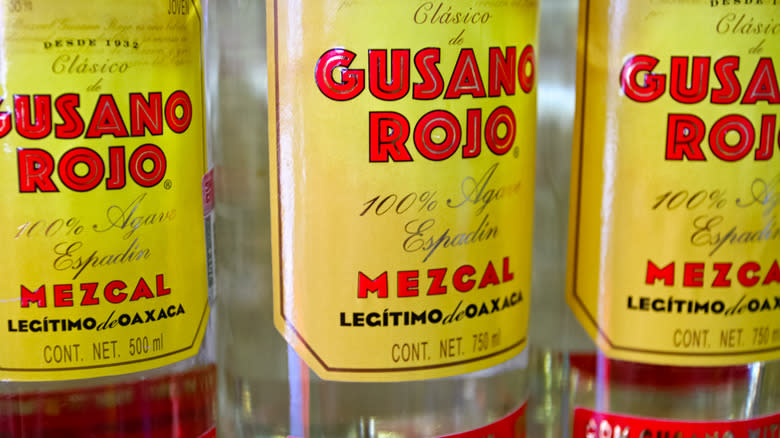The 'Fact' You Thought You Knew About The Worm In Tequila

Tequila connoisseurs will know every myth and fun fact about the iconic Mexican alcohol, one of the most infamous being the worm. Rumored to be a hallucinogenic, the worm at the bottom of the bottle represents all kinds of wild dares — like sneaking the worm into a shot — and even more outlandish stories. But the truth is a lot less far-fetched and much more culturally significant.
The worm in the bottom of your tequila isn't a worm at all, but a moth larvae officially named the gusano de maguey after the maguey plant from which it feeds. What's more, the tequila isn't actually tequila, for this tradition is tied explicitly to mezcal — a similar type of alcohol that originates in Oaxaca and uses agave as the key ingredient. With the myth now turned on its head, there is much history to delve into to uncover how the worm in tequila came to be and how the 'fact' about its hypnotic properties is actually fiction.
Read more: 26 Popular Vodka Brands, Ranked By Their Versatility
The History Of The Worm In Your Tequila

The gusano de maguey — which, remember, is a larvae, not an actual worm — are natural consumers of the agave plant from which mezcal is made. The particular gusano rojo, or red worm, eats the heart of the agave plant. When the agave is harvested and the heart is roasted and distilled into alcohol, sometimes a worm may be left inside, which is where the legend comes from, or at least how Jacobo Lozano Paez popularized it.
Stories say Paez is credited with adding the worm to finished bottles of mezcal as part of a marketing technique while employed at the mezcal company Nacional Vinicola, which is now Gusano Rojo. He claimed it changed the flavor of the alcohol and that the presence of the gusano made mezcal more pure. This attention-grabbing technique quickly spread to the U.S., where mezcal sellers were trying to differentiate themselves from tequila brands. The worm in the bottle evolved into a mark of authenticity and a distinguishing feature unique to mezcal. Of course, there are many other differences between mezcal and tequila that go beyond the worm.
You may be wondering, where did the hallucinogen myth come from? Certain gusanos de maguey also feed on peyote, which is known to cause hallucinations, and some claim that the worm inherits these qualities. Any real intoxication, however, comes from downing an entire bottle of mezcal before eating the gusano at the bottom.
More On Mezcal And Maguey Worms

While eating the gusanos de maguey may appear to be a fad associated with drinking and carrying on, it is actually a traditional part of Mexican cuisine, which is one of the things you may not have known about real Mexican food. These larvae have been a delicacy since Aztec times, often eaten by emperors and nobles; while they are not as common now, they still appear in dishes such as tamales and mixiotes.
Mezcal has gained traction in the alcohol world for more than just its wormy mystery; it also has a unique smoky taste that makes it great on its own and in cocktails. For those trying mezcal for the first time, seek it out in a traditional copita: A wide, clay bowl that allows you to smell the spirit better as you drink it. Professionals also advise that this alcohol is meant to be sipped and savored, not taken as a shot on the dance floor. Its smoky flavor makes for a great mezcal margarita, as well as in a negroni that brings out its natural earthy flavors.
Read the original article on The Daily Meal.


